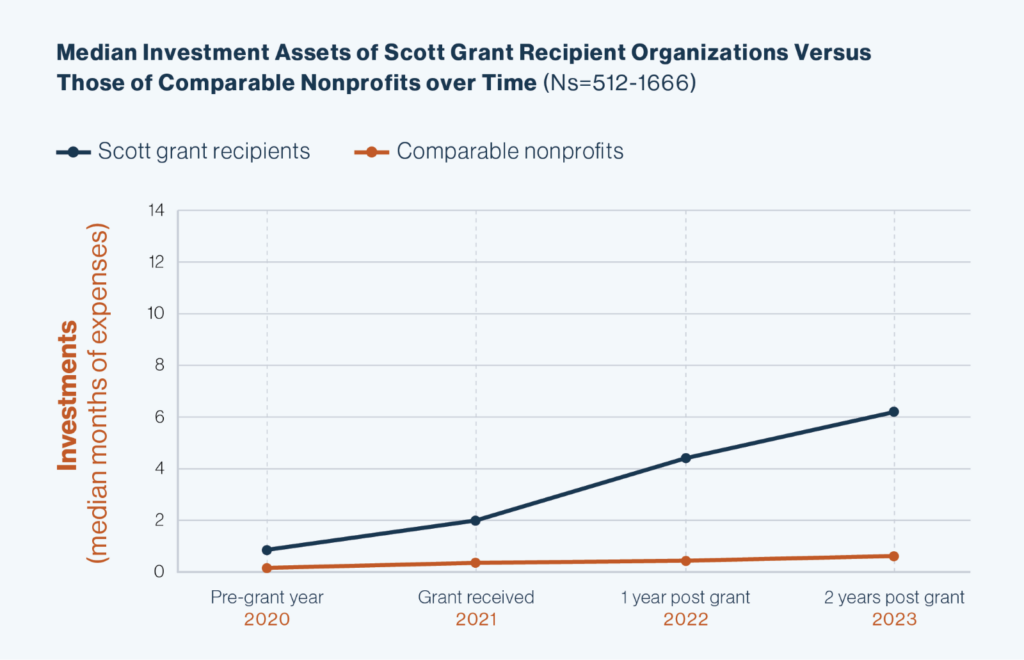Big, unrestricted gifts have a transformative effect on nonprofits that receive them. They can lead to greater financial strength and documented program results. They can also lead to increased confidence and reduced burnout of leaders. While foundation leaders have mixed views on these kinds of gifts, and they continue to worry about unintended negative consequences, the data belie those concerns.
Those are among the findings in “Breaking the Mold: The Transformative Effect of MacKenzie Scott’s Big Gifts,” the culmination of more than three years of in-depth analysis by the Center for Effective Philanthropy (CEP). This new report combines in-depth responses from Scott’s grantees with an analysis of 990 tax data that compares these organizations to like organizations that didn’t receive a gift from Scott.
It reveals that:
- Most leaders are managing grant funds to ensure their organization’s long-term financial sustainability, and few anticipate a financial cliff.
- Organizations are observing meaningful change created for communities.
- Leaders report Scott’s gifts increased their confidence in their own leadership, reduced their burnout, and sparked innovations in their programs and improvements in fundraising.
- While nonprofits have consistently reported positive effects of these large, unrestricted gifts, foundation CEOs have mixed perspectives on the approach.
Moving Toward Long-Term Financial Stability
The large infusion of unrestricted funding from Scott has so far resulted for most recipients in better long-term financial outlooks, with nearly 90 percent of nonprofit leader respondents indicating that the grant has moderately or significantly strengthened their organization’s long-term financial sustainability. What’s more, this year’s analyses of recipient organizations’ tax filings (Form 990s) demonstrate that the choices that organizations made about use of the grant funds they received have placed them in a stronger financial position than comparable organizations that did not receive a grant.
Form 990 data indicate that recipient organizations have grown their investment assets — mainly publicly traded investments and other securities — relative to their expenses in the two years after grant receipt, while comparable nonprofits’ investment assets have stayed essentially the same (see figure).

Finally, while many philanthropic onlookers feared that the size and unrestricted nature of Scott’s gifts would lead nonprofits to a “financial cliff,” fewer than 10 percent of nonprofit respondents anticipate having “a lot” of difficulty covering ongoing costs of initiatives funded by the grant.
Stronger Organizations, Stronger Communities
Indeed, most nonprofit leaders say their efforts funded by the grant have been somewhat or very successful in expanding existing programs to new populations or new geographies and engaging in new programs and most (nearly 70 percent) are collecting quantitative or qualitative information to understand the impact of their efforts funded by Scott’s gift. One leader said, “In 2021, we were reaching approximately 2.5 million people per day in [country] with nutritious meals. Following the grant and the respective growth, we now reach 10 million per day in both [country] and [country].”
Another said:
During the three years since we have received the grant, we have financed 33,521 loans for [a total of] $1.26 billion, with 82 percent serving low-income households and 68 percent representing people of color. These loans include 29,449 consumer loans, 2,233 home mortgage loans, and 489 consumer loans that our members used to buy homes, start or capitalize businesses, and otherwise address their household financial needs.
Stronger Nonprofit Leadership
Leaders also report that the Scott gift has been a boon for their own leadership, increasing their confidence, reducing burnout, and sparking innovation. One leader explained:
“As a young nonprofit leader of color, I have struggled with imposter syndrome that is far too often reinforced by officials and other leaders who are shocked that someone like me is in the position I am in. Receiving this grant has helped to rewrite my own narrative of who is capable of being a leader.”
Leaders with increased confidence were slightly more likely to innovate or take risks in their programs, raise their organization’s profile, and more. For some leaders, Scott’s grants provided breathing room and stability. More than one third of leaders indicate that receiving a Scott grant reduced their level of burnout.
Despite the Data, Funder Beliefs Remain Mixed
Nearly all foundation leaders surveyed see benefits to Scott’s approach to giving — and some see drawbacks to her approach as well.
Foundation leaders express varying levels of confidence in nonprofits’ ability to handle large gifts with no restrictions on how or when they must be used. One foundation leader said, “I view nonprofits as creative, high-functioning, ambitious organizations, so of course they can handle the gifts.” Another foundation leader expressed doubt, noting: “There are some organizations that simply can’t metabolize large gifts because of inadequate internal infrastructure and the inability to envision uses that can take their operations to the next level.”
For those still doubting whether Scott’s approach — granting large sums to trusted nonprofits doing impactful work in their communities and asking nothing in return but that they continue that good work — is a net positive, I refer you to CEP’s three years of research. We have found, again and again, that these gifts are transformative for organizations, emboldening of leaders, and meaningful for communities. Not everyone can or should give exactly the way Scott has but every funder and donor can learn from the clear impact she has made by trusting, giving generously, and removing burdens on recipients.
We will continue to watch with interest, and seek to learn from, her and other funders’ bold moves to support nonprofits and the communities they serve.
Ellie Buteau is director of research projects and special advisor on research methodology and analysis on the Research team at CEP. Find her on LinkedIn.


